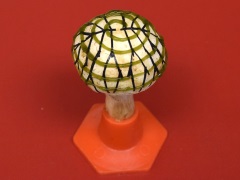Features
New powers under the spotlight
Date: 2018-11-15 12:31:21.0
Author: Jon Evans

Bionic button mushroom covered with a
branched electrode network and a spiral
pattern of cyanobacteria.
Photo: American Chemical Society.
Seemingly taking a leaf out of the Marvel universe, two new studies have demonstrated the benefits of using advanced nanomaterials to confer new powers on biological organisms.
One of these biological organisms is the humble button mushroom, which Manu Mannoor and his colleagues at the Stevens Institute of Technology in Hoboken, US, have transformed into a ‘bionic’ mushroom able to generate electricity from sunlight. This isn’t an entirely novel ability for biological organisms, as photosynthetic microorganisms such as cyanobacteria are known to release electrons during photosynthesis. But harnessing this ability to produce a biological solar cell has proved difficult, because it requires immobilizing living cyanobacteria on a surface while supplying them with sufficient water, nutrients and sunlight and hooking them up to an external circuit.
Mannoor and his colleagues wondered whether the caps of button mushrooms offered an ideal surface for this task. Other microbes are known to grow on mushroom caps, as they are a rich source of water and nutrients, and thus cyanobacteria should be able to grow on them as well. If the cap could also be covered with a network of electrodes, then any electrons released by the cyanobacteria could be captured to generate an electric current.
To apply electrodes and cyanobacteria to the cap of a button mushroom, Mannoor and his colleagues decided to turn them both into inks, allowing them to be printed onto the cap in specific patterns. For the electrodes, they used an ink made from graphene nanoribbons, while they created a cyanobacteria ink by immersing the cells in an alginate hydrogel. Using a robotic arm adapted to function as a 3D printer, they first printed a branched electrode network onto the mushroom cap and then printed the cyanobacteria in a spiral pattern. This ensured there were many points where the two networks contacted each other (see photo).
As Mannoor and his colleagues report in a paper in Nano Letters, their ‘bionic’ mushroom did indeed generate an electric current when illuminated. It also did this for several days, whereas cyanobacteria printed on a dead mushroom and on a plastic mushroom quickly stopped, showing that the cap of a living mushroom provides an ideal working environment for them.
Photosynthesis is also the basis of the enhancement a team of US scientists led by Neel Joshi at Harvard University have made to yeast (Saccharomyces cerevisiae), the microbial staple of biofuel production. As with all organisms that don’t normally photosynthesise, yeast needs to use some of the energy it generates from metabolizing nutrients for its own function and growth, rather than to produce a desired biofuel or biochemical, thus reducing its productivity. If, however, yeast could meet some of its energy requirements from sunlight, then it would have more energy available for producing the desired biofuel or biochemical.
To try to achieve this, Joshi and his colleagues experimented with covering the surface of yeast cells with light-harvesting indium phosphide nanoparticles. The idea is that the illuminated nanoparticles generate electrons that travel into the cell, where they become incorporated into the electron transport pathway that the yeast utilizes to produce both compounds for its own needs and a desired biofuel or biochemical.
As Joshi and his colleagues report in a paper in Science, they first tested this idea with a strain of yeast that had been genetically engineered for the production of shikimic acid, a precursor of aromatic amino acids that is also used in the production pharmaceuticals and fine chemicals. They found that yeast cells covered with nanoparticles and illuminated were able to produce 24 times more shikimic acid than unadorned yeast cells.
Both groups think their basic approaches to producing enhanced organisms could be utilized to confer a whole range of other powers as well. By printing other microbes, Mannoor and his colleagues think they could produce mushrooms that are luminescent or produce fuel, while Joshi and his colleagues think their nanoparticle coating could boost the production of various biochemicals produced by a wide range of different microbes.
The views represented here are solely those of the author and do not necessarily represent those of John Wiley and Sons, Ltd. or of the SCI.
Displaying 2 keywords used to tag this article:
- Jules Audemars-Australia Best Quali
- DG6582 Mens Moncler Down Jackets Gr
